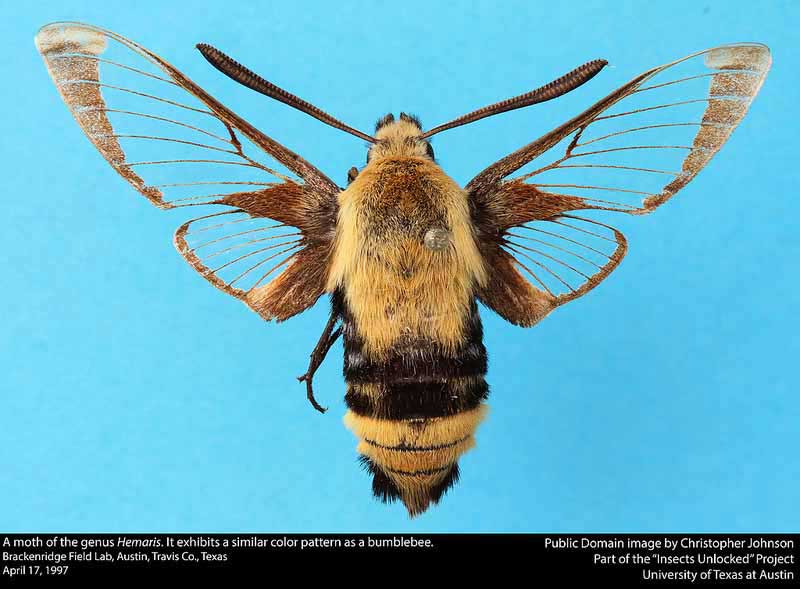
Hemaris sp.
Superregnum: Eukaryota
Regnum: Animalia
Subregnum: Eumetazoa
Cladus: Bilateria
Cladus: Nephrozoa
Cladus: Protostomia
Cladus: Ecdysozoa
Cladus: Panarthropoda
Phylum: Arthropoda
Subphylum: Hexapoda
Classis: Insecta
Cladus: Dicondylia
Subclassis: Pterygota
Cladus: Metapterygota
Infraclassis: Neoptera
Cladus: Eumetabola
Cladus: Endopterygota
Superordo: Panorpida
Cladus: Amphiesmenoptera
Ordo: Lepidoptera
Subordo: Glossata
Cladus: Coelolepida
Cladus: Myoglossata
Cladus: Neolepidoptera
Infraordo: Heteroneura
Cladus: Eulepidoptera
Cladus: Ditrysia
Cladus: Apoditrysia
Cladus: Obtectomera
Cladus: Macroheterocera
Superfamilia: Bombycoidea
Familia: Sphingidae
Subfamilia : Macroglossinae
Tribus: Dilophonotini
Subtribus: Hemarina
Genus: Hemaris
Subgenera: H. (Eitschbergera) – H. (Hemaris) – H. (Neojilinga)
Overview of species
H. aethra – H. fuciformis – H. galunae – H. molli – H. tityus –
Name
Hemaris Dalman, 1816
Synonyms
Mandarina Eitschberger, Danner & Surholt, 1998 (preoccupied by Mandarina Pilsbry, 1894 (Mollusca))
Eitschbergera Kemal & Koçak, 2005 (replacementname for Mandarina Eitscheberger et al., 1998)
Hemaris fuciformis
References
Additional references
Eitschberger, U., Kravchenko, V., Li, C.A., Speidel, W., Witt, T. & Müller, G.C. 2005: Zwei neue Hemaris Dalman, 1816-Arten (Subgenus Mandarína Eitschberger, Danner & Surholt, 1998) aus dem Nahen Osten (Lepidoptera, Sphingidae). Atalanta, 36(1-2): 199–208. Full article (PDF). Reference page.
Kemal, M. & A.Ö. Koçak, 2005: Nomenclatural notes on various taxa of the moths (Lepidoptera). Centre for Entomological Studies Ankara, Miscellaneous Papers 91/92: 11–14.
Schmidt, B.C. 2018. Cryptic species among bumblebee mimics: an unrecognized Hemaris hawkmoth (Lepidoptera: Sphingidae) in eastern North America. Zootaxa 4399(1): 32–48. DOI: 10.11646/zootaxa.4399.1.2. Full article (PDF) Reference page.
Hemaris is a genus of sphinx moths in the subfamily Macroglossinae, which is native to the Holarctic.[1] Their main host plants are herbs and shrubs of the teasel and honeysuckle families. Moths in genus Hemaris are known collectively as clearwing moths or hummingbird moths in the US and Canada and bee hawk-moths in Britain. The related Old World hummingbird hawk-moths, genus Macroglossum, are similar in appearance and habits. Both genera have tails that are provided with an expansile truncated tuft of hairs,[2] but only Hemaris has the disc of the wings transparent, as these scales are dropped soon after eclosion.
Description
The eggs are small, spherical, and pale glossy green in color. Host plants include shrub and vining honeysuckles and teasels.
The larvae are small, cylindrical, and covered in granules that often have small bristles. Most larvae are green, brown, and gray, but there are many color forms. All have a distinctive pale dorsolateral longitudinal stripe from head to horn.
The pupa is enclosed in a loosely spun cocoon, and is glossy in most species. There is a prominent tubercle or hook alongside each eye. The cremaster of the chrysalis is large and flattened.
The imagoes, or adults, are small, diurnal moths that resemble bumblebees in shape. They are often mistaken for hummingbirds. The forewings are fully scaled, but in some species patches of scales are lost during the first flight, leaving a glassy hyaline area on each wing. The antennae are strongly clubbed in both sexes and each has a small, recurved hook at the end. The abdomen ends in a large fan of setae.
The genitalia of the male are asymmetrical; the uncus is divided into two subequal lobes and is sclerotized. The ostium bursae, or genital opening, of the female is angled to the left.
File:Hemaris-Hummingbird-Moth.oggPlay media
A Hemaris feeding on flowers in Minnesota.
Species
There are 23 accepted species. Four species are native to North and South America, and three to Europe.[3]
Hemaris aethra (Strecker, 1875) – Diervilla clearwing[4]
Hemaris affinis Bremer, 1861 – honeysuckle bee hawkmoth
Hemaris aksana (Le Cerf, 1923) – Atlas bee hawkmoth
Hemaris alaiana (Rothschild & Jordan, 1903) – Alai bee hawkmoth
Hemaris beresowskii Alpheraky, 1897
Hemaris croatica (Esper, 1800) – olive bee hawkmoth
Hemaris dentata (Staudinger, 1887) – Anatolian bee hawkmoth
Hemaris diffinis (Boisduval, 1836) – snowberry clearwing
Hemaris ducalis (Staudinger, 1887) – Pamir bee hawkmoth
Hemaris fuciformis (Linnaeus, 1758) – broad-bordered bee hawk-moth
Hemaris galunae Eitschberger, Müller & Kravchenko, 2005 – Levant bee hawkmoth
Hemaris gracilis (Grote & Robinson, 1865) – slender clearwing or graceful clearwing
Hemaris molli Eitschberger, Müller & Kravchenko, 2005
Hemaris ottonis (Rothschild & Jordan, 1903)
Hemaris radians (Walker, 1856)
Hemaris rubra Hampson, [1893] – Kashmir bee hawkmoth
Hemaris saldaitisi Eitschberger, Danner & Surholt, 1998
Hemaris saundersii (Walker, 1856) – Saunders' bee hawkmoth
Hemaris staudingeri Leech, 1890
Hemaris syra (Daniel, 1939) – Syrian bee hawkmoth
Hemaris thetis Boisduval, 1855 – Rocky Mountain clearwing or California clearwing
Hemaris thysbe (Fabricius, 1775) – hummingbird clearwing
Hemaris tityus (Linnaeus, 1758) – narrow-bordered bee hawk-moth
Hemaris venata (Felder, 1861)
References
Kitching, I. J. and J. Cadiou (2000). Hawkmoths of the World. An Annotated and Illustrated Revisionary Checklist (Lepidoptera: Sphingidae). Cornell University Press, New York. ISBN 0-8014-3734-2
Imms, A. D.; Davies, O. W.; Richards, R. G. (1977). Imms' General Textbook of Entomology Volume 2: Classification and Biology (10th ed.). Dordrecht: Springer Netherlands. p. 1139. ISBN 9789401165167.
Fauna Europaea Hemaris Dalman 1816
7855.2 – Hemaris aethra – (Strecker, 1875), North America, Moth Photographers Group
Retrieved from "http://en.wikipedia.org/"
All text is available under the terms of the GNU Free Documentation License


